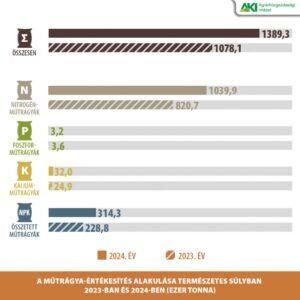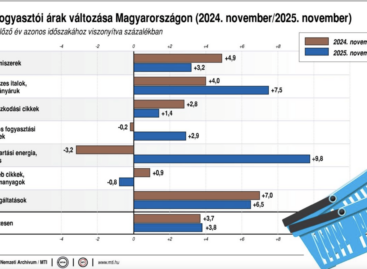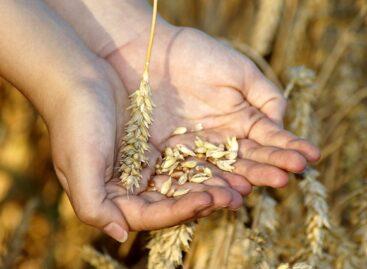Fertilizer prices fell, sales volume increased
Fertilizer distributors sold 1.39 million tons of fertilizer directly to farmers in 2024. The sales volume exceeded the previous year by 28.9 percent. Fertilizer prices were 24.6 percent lower on average, according to the Central Statistical Office (KSH), so net sales revenue from fertilizer sales fell by 8.1 percent to HUF 208.7 billion in 2024, despite the increase in volume.

As in previous years, the highest demand was for lime ammonium nitrate (MAS): it accounted for 46 percent of the total fertilizer turnover, with nearly 642 thousand tons sold to farmers. The share of MAS in terms of total volume increased by 3 percentage points in the current year compared to 2023. The second most popular product among granular fertilizers was urea (83 thousand tons), which covered 6 percent of total fertilizer sales, compared to 88 thousand tons in 2023, which then represented 8 percent of total sales. 15 thousand tons of ammonium nitrate were purchased, compared to 11 thousand tons in the base year, this represents an increase of 36 percent, while almost half of the amount in 2022. The proportion of solution fertilizers was almost 15 percent of the total sold volume in the period under review, two-thirds of which were nitrosol, DAM (30%), these proportions did not change compared to the previous year. The demand for superphosphate with an active ingredient content of 18–20.5 percent was 2.5 thousand tons, 400 tons higher than the base year, while the sale of potassium chloride increased by 6 thousand tons (29 thousand tons) in 2024. Among the compound fertilizers, the largest quantities were sold in the NPK 15-15-15 and 10-26-26 compositions (47-47 thousand tons), more than twice as much of the 10-26-26 composition was sold in the current year as in 2023 (Table 12). The third largest quantity was NP 18-46 (23 thousand tons). Other compositions sold in significant quantities in 2024 were NPK 7-21-21 and NP 12-52 (MAP), both with 17 thousand tons. The volume of MAP started to increase from last year’s 8 thousand tons, but it is still far from reaching the volume of around 36 thousand tons in 2020.
AKI PÁIR
Related news
KSH: in November, consumer prices exceeded the values of the same month of the previous year by an average of 3.8 percent
🎧 Hallgasd a cikket: Lejátszás Szünet Folytatás Leállítás Nyelv: Auto…
Read more >New era in plant breeding: EU agrees to regulate genetically modified plants
🎧 Hallgasd a cikket: Lejátszás Szünet Folytatás Leállítás Nyelv: Auto…
Read more >Ministry of Agriculture supports the food industry’s adaptation to new challenges
🎧 Hallgasd a cikket: Lejátszás Szünet Folytatás Leállítás Nyelv: Auto…
Read more >Related news
The Hungarian Confederation of Economic Workers also spoke out regarding the inflation data
🎧 Hallgasd a cikket: Lejátszás Szünet Folytatás Leállítás Nyelv: Auto…
Read more >KSH: in November, consumer prices exceeded the values of the same month of the previous year by an average of 3.8 percent
🎧 Hallgasd a cikket: Lejátszás Szünet Folytatás Leállítás Nyelv: Auto…
Read more >In addition to jelly and marzipan Christmas candy, there are more and more specially flavored Christmas desserts on offer
🎧 Hallgasd a cikket: Lejátszás Szünet Folytatás Leállítás Nyelv: Auto…
Read more >






